Epics, features, and user stories are fundamental components of Agile project management. They serve as essential building blocks that collectively guide the development process towards successful outcomes. With their distinct key roles, they collectively define the scope and requirements of a project while ensuring alignment with stakeholders’ needs and contributing to iterative development.
Aloa, a leading software outsourcing firm, is recognized for its meticulous approach to project management. Our vast network comprises skilled developers proficient in epics, features, and user story implementation. With our dedication to transparency, you’ll receive regular progress updates to ensure confidence in the project’s direction and alignment with your goals.
This blog will explore the key differences between epics, features, and user stories that benefit startups, project managers, and product owners. By the end, you’ll clearly understand how these elements play distinct roles in Agile project management to empower you to make informed decisions for your projects.
Let’s dive in!
Epics vs Features vs User Stories: What’s the Difference?
In project management, epics, features, and user stories all play essential roles. Epics represent initiatives that set the project's direction. Features, on the other hand, are distinct functionalities that contribute to achieving these Epics. Meanwhile, user stories provide detailed descriptions of specific tasks required to fulfill each feature's requirements.
Using epics, features, and user stories allows teams to optimize their workflow, prioritize tasks, and deliver high-quality solutions aligning with user expectations and business objectives. This comprehension empowers teams to effectively manage project scope, allocate resources efficiently, and adapt to evolving requirements.
Core Differences Between Epics Features and User Stories
Epic features and user stories have core differences that define their roles within project management frameworks. Here are a few of them that aid in a well-functioning development process and ultimately contribute to project success:
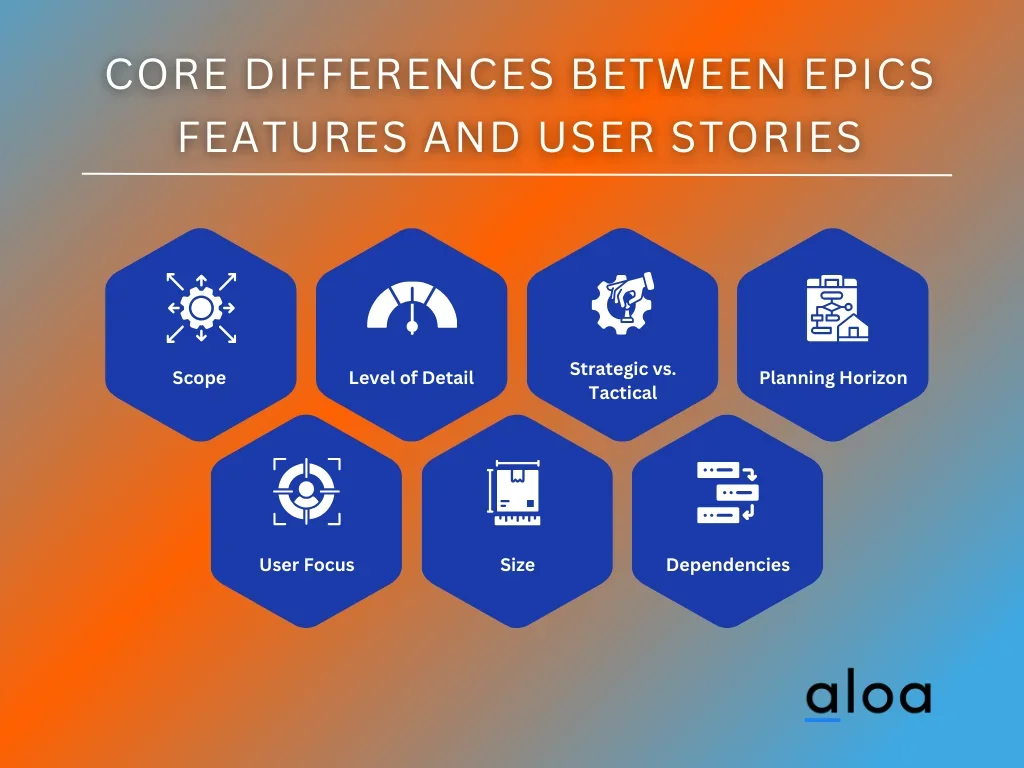
Scope and Size
- Epics are large user stories that encompass multiple smaller stories or tasks. They are too big to be completed within a single sprint and may take up to a quarter of the calendar year to finish.
- Features are distinct product capabilities or characteristics being developed. More often, they’re considered as user stories that are big enough to be released independently or those that users will likely notice and appreciate.
- User stories are specific requirements or functionalities that users may want. Smaller in scope compared to epics and features, they focus on delivering value efficiently.
Granularity and Detail
- Epics provide a high-level overview and outline the broader goals or themes of a project, often described in a user story or elevator pitch format.
- Features offer a more detailed overview compared to epics, providing clarity and context to development teams about what needs to be built while aligning with goals.
- User stories are the most granular and detailed, typically written in a structured format like, "As a [type of user], I want [some goal] so that [some reason]."
Planning and Execution
- Epics serve as guiding principles during initial planning that help teams understand the overall direction and purpose of the project.
- Features aid in prioritizing tasks and understanding the potential success of a product, enabling teams to focus on delivering value efficiently.
- User stories are actionable items from the product backlog to the sprint backlog during sprint or iteration planning, providing a clear focus for development teams.
Timeframe and Completion
- Epics may span longer timeframes, often requiring multiple sprints or iterations to complete due to their size and complexity.
- Features are usually smaller than epics but may still require significant effort to complete, potentially taking up one or more sprints based on their size and scope.
- User stories are smaller and more manageable, typically completed within a single sprint or iteration that allows for faster delivery of value to users.
Hierarchy and Organization
- Epics, features, and user stories follow a hierarchical structure, with epics representing the highest-level goals or themes. This is followed by features that contribute to achieving those goals, then user stories to fulfill those requirements.
- Epics can be broken down into smaller features or user stories to provide a structured approach to project management and execution.
Adaptability and Flexibility
- Epics allow for flexibility in project planning, as they can be refined and broken down into smaller stories or tasks as more information becomes available.
- Features provide adaptability by allowing teams to focus on specific areas of product development based on changing priorities and customer needs.
- User stories offer flexibility in implementation that allows the development teams to adjust and refine requirements based on feedback and evolving user needs.
Communication and Collaboration
- Epics facilitate communication and collaboration among stakeholders by providing a shared understanding of the project's scope and objectives.
- Features foster collaboration by enabling teams to prioritize tasks and allocate resources effectively to achieve project goals.
- User stories promote collaboration between development teams and stakeholders by defining requirements and functionalities that align with user needs and expectations.
Understanding these core differences between epics, features, and user stories is crucial for the effective Agile product development process. It empowers teams to prioritize tasks, allocate resources efficiently, and deliver value to stakeholders.
Relationship Between Epics Features and User Stories
Aside from core differences, epics, features, and user stories have relationships crucial to product management. Below are the relationships between these components and how they interact to drive project success.
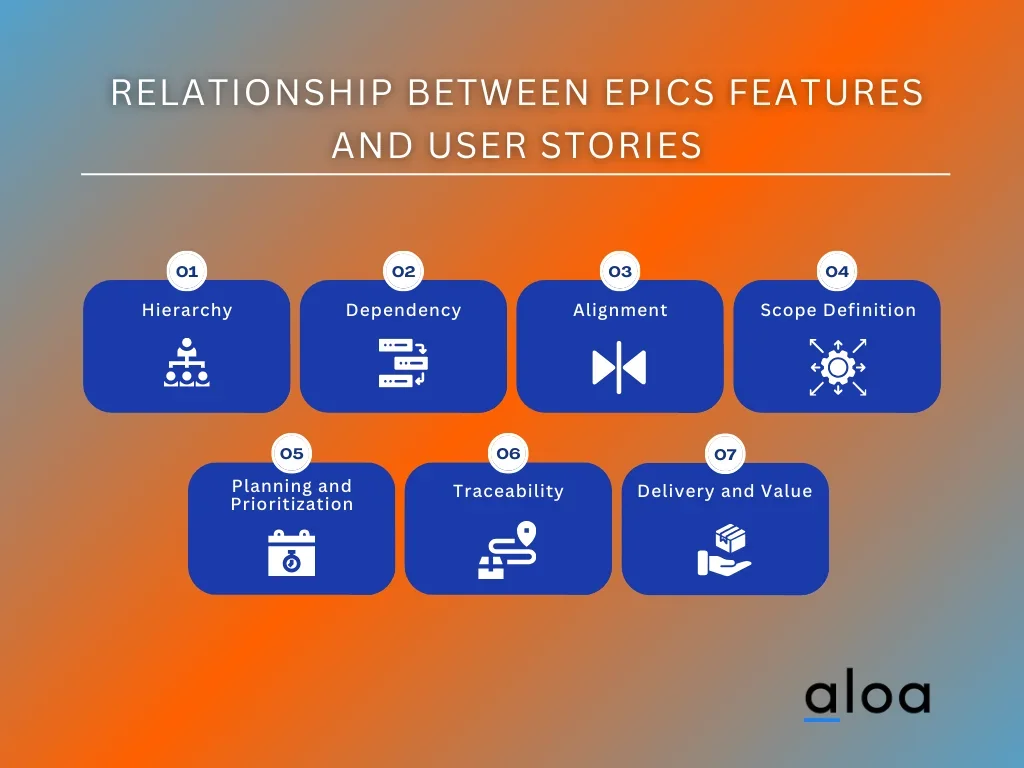
Structural Hierarchy
Epics serve as overarching project goals, representing large bodies of work that encapsulate multiple features and user stories. Features, on the other hand, are distinct capabilities or characteristics of the product, contributing to the achievement of epics. User stories provide granular requirements within features that detail specific tasks or functionalities needed to fulfill feature objectives.
Agile Planning and Iterative Development
Epics, features, and user stories facilitate Agile planning and iterative development by breaking down project requirements into manageable components. Epics initiate the planning process to guide the identification and prioritization of features and user stories for each development iteration. This iterative approach allows teams to incrementally deliver value, gather feedback, and adapt project priorities based on evolving requirements.
Progressive Elaboration
Epics initiate the process of progressive elaboration by outlining broad project objectives, which are progressively broken down into more detailed features and user stories as additional information becomes available. This iterative refinement allows teams to continuously refine and clarify project requirements to ensure alignment with evolving business needs and customer expectations.
Scope Definition
Epics define the overall scope and direction of a project to provide a high-level view of desired outcomes. Features further define the scope by specifying distinct functionalities or characteristics that contribute to achieving epic objectives. User stories then define specific user requirements and interactions within each feature to guide the implementation of detailed functionality.
Prioritization Framework
Epics, features, and user stories provide a hierarchical framework for prioritizing project requirements based on business value and stakeholder needs. Epics define project goals that guide the prioritization of features essential for achieving those goals. User stories within features offer granular prioritization criteria that enable teams to focus on implementing high-priority functionalities that align with user needs.
Dependency Management
Epics may encompass multiple features and user stories that establish dependencies between various components of a project. Features often rely on the completion of related epics, while user stories within features may have interdependencies that impact task sequencing and prioritization. Effective management of these dependencies ensures cohesive development and timely delivery of project milestones.
Communication and Collaboration
Epics, features, and user stories serve as communication tools that facilitate collaboration and alignment among stakeholders, product owners, and development teams. Epics provide a common understanding of project objectives, while features and user stories enable detailed discussions on specific functionalities and user requirements. Clear communication and collaboration among stakeholders ensure shared vision and effective delivery of project outcomes.
Use Case For Epics
When considering the use case for epics in Agile project management, it’s essential to understand their significance in setting overarching project goals. Below, we’ll delve into the specific use cases for epics and how they serve as valuable tools for organizing and prioritizing work in complex projects.
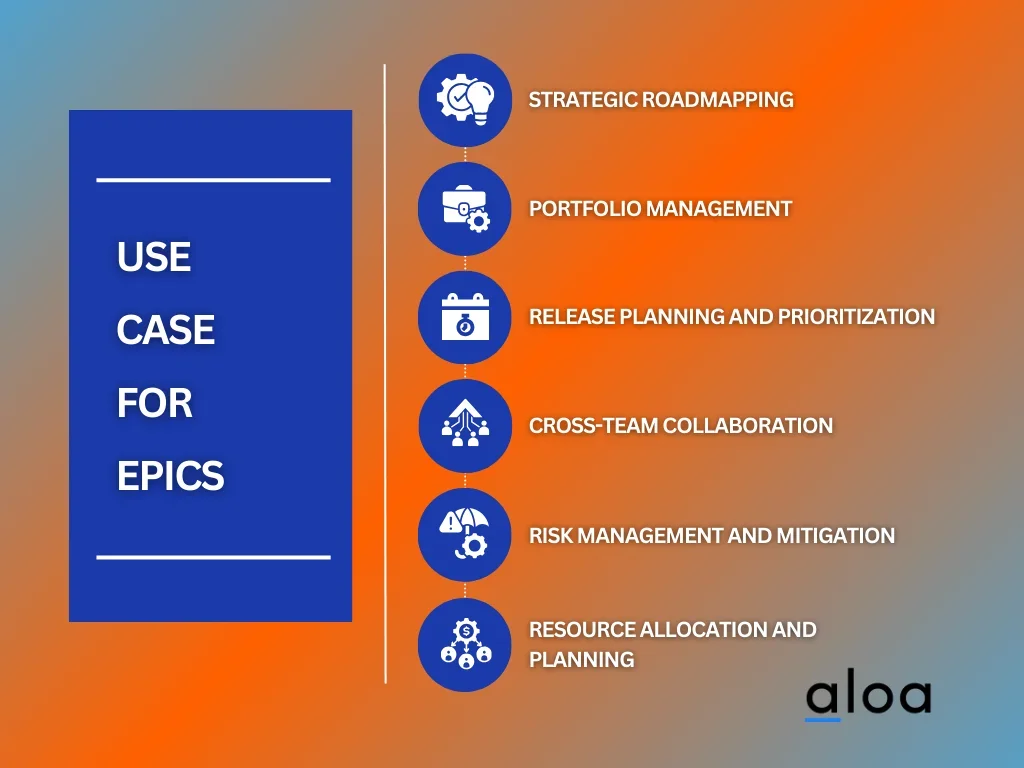
Strategic Roadmapping
An epic defines high-level strategic goals and initiatives that provide a roadmap for the project’s direction. They help stakeholders and development team members visualize the big picture and prioritize efforts based on long-term objectives. Additionally, epics facilitate strategic planning by breaking down complex projects into manageable chunks, allowing teams to focus on key milestones and deliverables.
Portfolio Management
Epics enables organizations to prioritize and manage multiple projects concurrently in portfolio management. They provide a holistic view of all projects within a portfolio that helps stakeholders make informed decisions about resource allocation and prioritization.
Categorizing projects into epics enables organizations to align their project portfolios with strategic objectives and business priorities. This alignment ensures that resources are allocated to projects that deliver the most value and contribute significantly to the organization’s overall goals.
Release Planning and Prioritization
Epics are instrumental in release planning as they help prioritize and sequence features or user stories for upcoming releases. They enable product owners and teams to identify critical functionalities or requirements that need to be delivered in each release.
In breaking down epics into smaller features or user stories, teams can estimate effort, allocate resources, and define release milestones more accurately.
Cross-Team Collaboration
Epics facilitates cross-team collaboration by providing a shared understanding of project goals and objectives across different departments or teams. They serve as a common language for communication and coordination to ensure all stakeholders are aligned on project priorities and expectations. As a result, epics minimize duplication of work and streamline project execution through identification of dependencies and coordination efforts.
Risk Management and Mitigation
Epics are instrumental in risk management as they help identify and mitigate potential risks and challenges that may impact project delivery. They also provide a structured framework for stakeholders and project managers in assessing project risks based on its severity and impact.
Resource Allocation and Planning
Epics assist in resource allocation and planning by defining the specific tasks or requirements that need to be completed. They enable teams to estimate effort, allocate resources effectively, and define milestones for feature delivery. Epics help stakeholders make informed decisions about resource allocation so that resources are allocated to tasks that contribute most significantly to project success.
Use Cases For Features
Features in Agile project management serve as essential building blocks that translate high-level epics into tangible functionalities. They represent a collection of related user stories that detail specific requirements and functionalities.
Below are the use cases for Features in software development that demonstrate how they contribute to your project’s overall success.
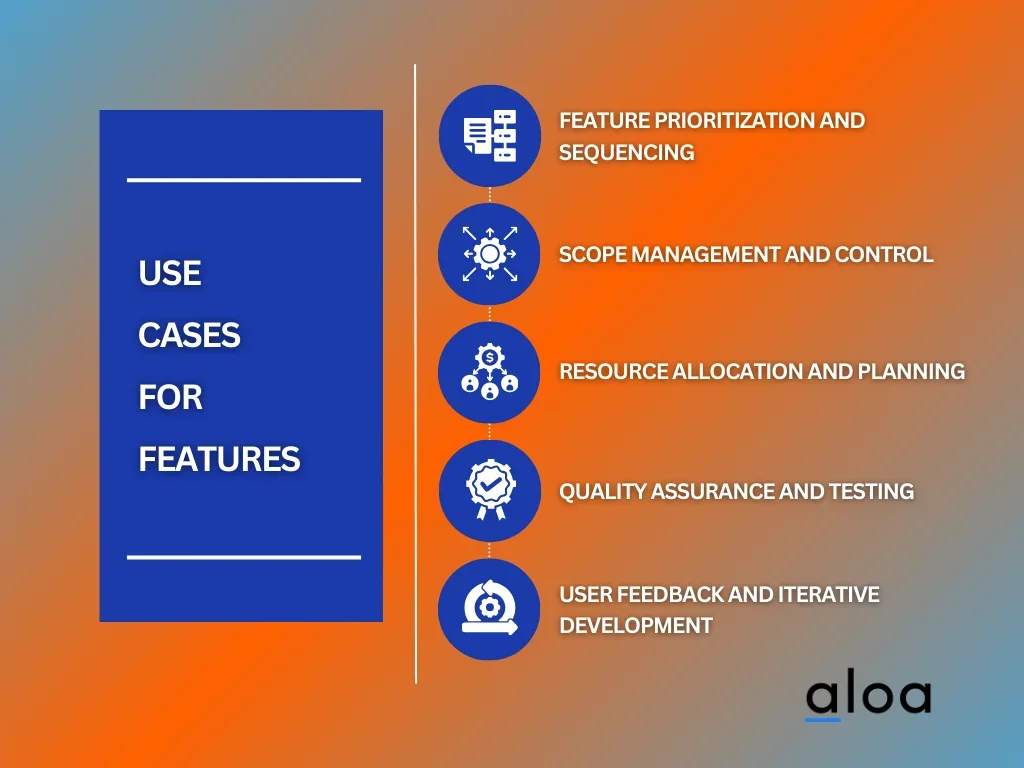
Feature Prioritization and Sequencing
Features act as overarching functionalities or capabilities that provide value to end users. Much like a group of smaller user stories, these features can be further decomposed into more granular tasks or functionalities. This breakdown allows teams to manage and prioritize their work effectively to ensure that each increment contributes meaningfully to the overall feature and delivers value to the customer.
Scope Management and Control
Features play a crucial role in managing and controlling the scope of a project. They clearly define the functionalities or characteristics that must be delivered to prevent scope creep and ensure project objectives are met within the defined constraints. More importantly, features allow stakeholders to track progress and monitor the development process to ensure the project stays on track and aligns with stakeholder expectations.
Resource Allocation and Planning
As a group of smaller stories, features play a crucial role in resource allocation and planning within software development projects. They help define the specific tasks or requirements that need to be completed, enabling teams to estimate effort, allocate resources effectively, and define milestones for feature delivery. This understanding ensures that resources are allocated to tasks that contribute most significantly to project success.
Quality Assurance and Testing
Features are instrumental in quality assurance and testing processes. They provide a basis for developing test cases and conducting validation activities to ensure the implemented functionalities meet the specified requirements. In this case, Features enable teams to identify potential issues or defects early in the development process that will facilitate timely resolution and ensure the delivery of high-quality solutions to end users.
User Feedback and Iterative Development
Features facilitate user feedback and iterative development by providing a framework for implementing incremental changes based on user input. They enable teams to prioritize enhancements or modifications based on user needs and preferences, ensuring that the product evolves to meet changing requirements. Features allow stakeholders to incorporate user feedback into the development process.
Use Cases for User Stories
User stories are fundamental components of modern project management methodologies. They track work and represent key functions of the product, each contributing to a distinct part of the product. Let’s explore the essential use cases for user stories.
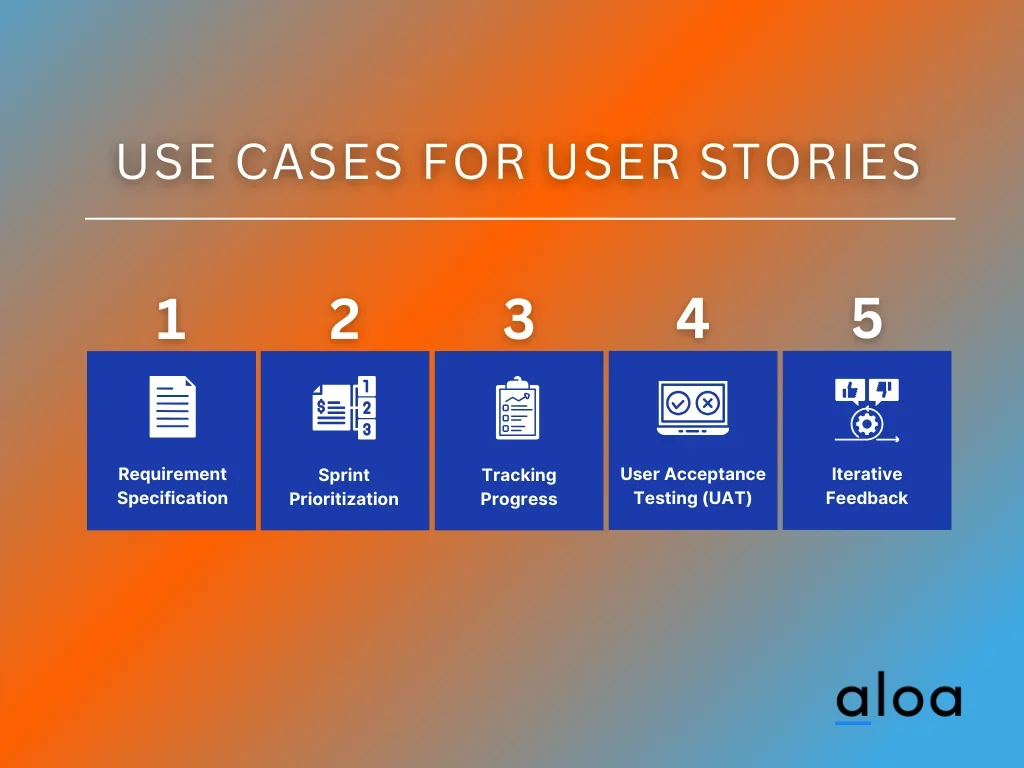
Detailed Requirement Specification
User Stories serve as detailed requirement specifications by describing specific tasks or functionalities from an end user’s perspective that guide the team toward the end goal. They provide a clear and concise description of what needs to be accomplished to ensure that development efforts align with user needs and expectations.
Prioritization and Sprint Planning
User Stories assist in prioritizing tasks and planning sprints by defining the most important features or functionalities to be developed. They enable product owners and teams to prioritize tasks based on user value and business impact to ensure that the most critical requirements are addressed first.
Progress Tracking and Monitoring
User Stories facilitate progress tracking and monitoring by breaking project tasks into manageable work units. They provide a basis for tracking the completion of individual tasks to monitor progress and identify any potential delays or bottlenecks in the development process.
User Acceptance Testing (UAT)
User Stories are used for user acceptance testing (UAT) by defining the criteria for validating that the implemented functionalities meet user expectations. They serve as a basis for developing test cases and conducting UAT activities to ensure that the product meets the specified requirements and delivers value to end users.
Continuous Feedback and Iterative Improvement
User Stories facilitate continuous feedback and iterative improvement by providing a framework for incorporating user input into the development process. They enable teams to gather feedback from stakeholders and end users throughout the development cycle. This allows continuous product refinement and improvement to better meet user needs and key preferences.
Key Takeaway
Understanding the differences between epics, features, and user stories is essential for effective project planning and execution. It allows teams to accurately define project scope, prioritize tasks, and allocate resources efficiently. Leveraging the distinct characteristics of each component, teams can ensure alignment with stakeholder needs and deliver high-quality solutions.
Delving deeper into how epics, features, and user stories benefit project teams is pivotal in fostering effective communication and collaboration among team members. This in turn nurtures a cohesive and productive working environment, allowing teams to feel empowered when sharing their insights and fostering collaboration towards achieving common goals.
Want to dive deeper into epics, features, and user stories? Check out our blog page for more articles packed with valuable content about Agile project management. Whether you’re a seasoned pro or new to the field, our resources will support your journey toward success by implementing agile frameworks to your project development needs.

